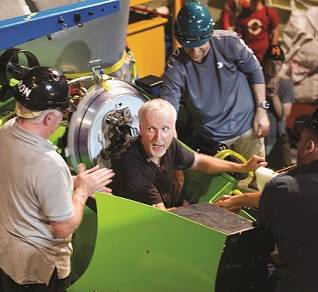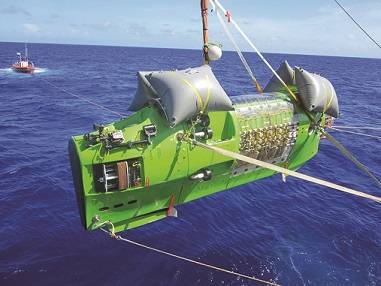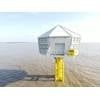SubConn, James Cameron and WHOI Face Deepsea Challenges
Following a cross-country journey with stops at science institutions, museums and even Capitol Hill, filmmaker and explorer James Cameron recently handed over the Deepsea Challenger, the only human occupied vehicle currently able to access the very deepest parts of the ocean, to Woods Hole Oceanographic Institution (WHOI). Here, this impressive submersible system will be put to good use as a state-of-the-art scientific platform for future deep sea missions.
The Deepsea Challenger
Enabling James Cameron to make his nearly 11-kilometer descent to the deepest place on earth, exploring the ocean floor, conducting experiments, collecting samples, and returning safely to the surface, requires an underwater vehicle unlike any other. As with spaceships, deep-sea submersibles must be engineered to accommodate innumerable challenges, including extreme changes in pressure, temperature and the incessant absence of sunlight.
It took James Cameron and his team seven years to complete the Deepsea Challenger, and the challenges related to this process spanned the incorporation of several new technologies, designs and materials - along with extensive testing. From its unique vertical attitude to its purpose developed materials, including highly sophisticated syntactic foam developed specifically to withstand the immense pressure at the very bottom of the ocean, the vehicle represents a significant showcase of engineering innovation.
Standard connectors on a special mission
Almost everything on the Deepsea Challenger is custom designed and tailor-made for its specific purpose, as the vehicle can rely on only the most expertly engineered systems and components, designed to function unfailingly under enormous strain. Amongst these, however, the many stainless steel PBOF and bulkhead SubConn connectors, supplied by Ocean Innovations, mark an impressive exception to prove the rule. Tested explicitly to work at extreme depths, these industry standard connectors are used to interface the vehicle battery packs, the powerful spot and LED panel lighting arrays, HD and IMAX quality 3D cameras, along with and other vital instruments and sensors used on the Deepsea Challenger. In addition, SubConn connectors, including glass sphere modified units, were widely used to interface the two unmanned robotic landers that descended to perform pre-programmed tasks in the abyss - prior to the arrival of the Deepsea Challenger.
James Cameron, WHOI and SubConn
Easily recognizable by their characteristic red locking sleeves, SubConn connectors have been widely used by ocean professionals in offshore, ocean science, civil engineering and defense sectors across the world.
James Cameron as well as WHOI have maintained a long standing history and track record with regards to the use of SubConn connectors for interfacing underwater technology and equipment. Since 1995, when the filming for Titanic started, James Cameron has continuously selected SubConn as the connectivity solution of choice for several of his underwater projects. Likewise, WHOI has been using SubConn connectors, along with other products and solutions from global SubConn distributor, the MacArtney Group, for realizing a vast variety of oceanographic applications, systems and technologies.

















 December 2025
December 2025



